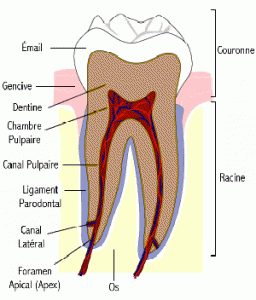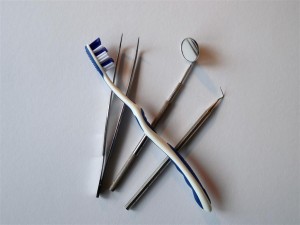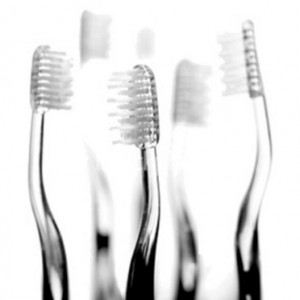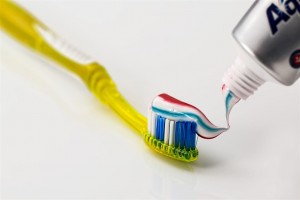Humans have 20 primary teeth that are used throughout childhood and are then replaced by 32 permanent teeth. Teeth are made of a substance called dentin which resembles bone. The visible portion of a tooth is called the crown and is completely covered with enamel, the hardest substance in the human body. Inside each tooth, you can find the pulp chamber that contains connective tissue, blood vessels and of course, nerves. Teeth are attached to the jaw by a periodontal ligament that connects the root to the bone.
 Teeth can be categorized onto four groups: incisors, canines, premolars and molars. The front teeth are incisors. They serve to cut the food and help with pronunciation and appearance. Then, we have the canines, also known as the anterior pillars of the jaw or eye teeth. Not only do they help cut food but they also guide the lower jaw in its movements. After the canines, we have the premolars, followed by molars which have large flat surfaces used to chew food.
Teeth can be categorized onto four groups: incisors, canines, premolars and molars. The front teeth are incisors. They serve to cut the food and help with pronunciation and appearance. Then, we have the canines, also known as the anterior pillars of the jaw or eye teeth. Not only do they help cut food but they also guide the lower jaw in its movements. After the canines, we have the premolars, followed by molars which have large flat surfaces used to chew food.
The gum surrounding the teeth protects the bones and holds the teeth in place. Teeth must fall out in a specific order. If they don’t, there may be a lack of available space in the future that will lead to crooked teeth which makes cleaning more difficult.
Clinical Exam
During the physical examination, we look for signs of gum disease, cancer, cavities, broken fillings, wear and hypermobility of the teeth. Then, we must check the occlusion (the way the teeth close together) and the contact between the teeth (if teeth are too tight, hygiene at home is more complicated for the patient who does not take the time to floss. On the other hand, if the contacts are not strong enough, the food will always get stuck between the teeth and cause bad breath). Then, we remove the plaque and subgingival tartar build-up which cannot be removed with simple brushing. If the amount of tartar is too large, the patient may need more intensive gum treatment.
The following step is the polishing the teeth to remove stains. The final step is flossing. If necessary, your dentist will suggest some techniques to improve your oral hygiene. The duration of this exam is usually between 30 and 60 minutes.
We recommend two exams and cleanings per year. These routine visits are essential to maintaining a good oral health and should not be neglected even if everything seems fine.
Brushing technique
The best way to avoid plaque build-up is by regularly brushing and flossing the teeth. The toothbrush should be soft or extra soft to avoid damaging the soft tissues of the mouth. The size should fit the mouth to reach every corner. A proper brushing technique will keep you from damaging your teeth.
Steps to follow:
1. Place the brush at 45 degrees against the gum.
![Brossage1[1]](http://www.beausourire.com/wp-content/uploads/2015/11/Brossage11.gif)
2. Make small moves back and forth to thoroughly clean the space between the teeth and gum (without moving the toothbrush too much).
![Brossage2[1]](http://www.beausourire.com/wp-content/uploads/2015/11/Brossage21.gif)
3. Rotate as you move away from the gum.
4. Repeat steps 1 to 3, three times per tooth.
![Brossage3[1]](http://www.beausourire.com/wp-content/uploads/2015/11/Brossage31.gif)
5. Do not forget to brush the top of the teeth.
![Brossage4[1]](http://www.beausourire.com/wp-content/uploads/2015/11/Brossage41.gif)
6. Use the tip of the toothbrush to reach less accessible areas.
![Brossage5[1]](http://www.beausourire.com/wp-content/uploads/2015/11/Brossage51.gif)
7. You should also brush your tongue, the inside of your cheeks and your palate.
Cleaning

To maintain a good oral hygiene, you should visit the dentist regularly. Even if you brush your teeth and floss at home, your teeth should be cleaned professionally every six months. Professional cleaning removes plaque and tartar that build up on teeth and under the gum despite your good hygiene habits.
During the exam session and cleaning, the dentist will examine your teeth, gums, tongue, mouth, throat, your neck and temporo-mandibular joint. Normally (according to the need perceived by the dentist), x-rays may be needed for a better view of dental structure and bones. These x-rays are not dangerous for the patient and are used to detect elements that aren’t visible to the naked eye such as:
- cavities between the teeth, under the gum and old fillings;;
- bone loss that occurs with advanced periodontis;
- the teeth that are blocked under the gum, especially wisdom teeth;
- large or crooked roots that need special attention after a root canal or other restoration;
- abscesses and infections that form in the roots of decayed teeth;
- cracks or bone abnormalities.
X-rays are safe because people are exposed to very small amounts of radiation. Nowadays, X-ray machines emit a small amount of radiation on a specific location and the speed of the film decreases the amount of radiation required. Furthermore, all appliances are regularly checked to ensure the safety of the patients and dental staff. Furthermore, an apron and collar made out of lead provide efficient protection against small amounts of radiation that could escape from the device. We have recently equipped our clinic with a digital radiography system that reduces radiation up to 90%.
Bad Breath (Halitosis)
It is highly likely that you know someone (maybe even yourself) who suffers from bad breath. This is a very annoying problem but there are solutions. There are many causes for this disease and the solution becomes obvious when the source of the problem is discovered.
The most common cause of bad breath is as simple as the ingestion of foods that contain garlic, onions or other strong smelling ingredients. This odor will remain in the mouth as long as your body is digesting these specific ingredients. The smell can be reduced by eating pills of activated charcoal (available at pharmacies). Sometimes the underlying cause of halitosis can be more serious such as the presence of cavities, gingivitis, abscesses, dry mouth (xerostomia), or systemic diseases (diabetes, etc.). The use of different drugs or smoking can also cause bad breath.
Other systemic causes include health problems such as respiratory diseases, chronic sinusitis, chronic bronchitis, diabetes, gastrointestinal diseases, and kidney or liver issues. A dry mouth can also cause halitosis. This dryness may be due to the usage of certain medications, mouth breathing or a problem with the salivary glands.
Poor oral hygiene can allow an accumulation of bacteria in the mouth, causing bad breath. Therefore, the first step is to ensure that the problem is not related to the teeth by having an impeccable oral hygiene and regular dental follow-ups to avoid gum problems and tooth decay.
Flossing
![cdcvm_flossing[1]](http://www.beausourire.com/wp-content/uploads/2015/11/cdcvm_flossing1.jpg) This is an important part of good oral hygiene and the only way to clean between your teeth. Since the toothbrush cannot reach these areas, flossing becomes an indispensable element. These are the steps to follow:
This is an important part of good oral hygiene and the only way to clean between your teeth. Since the toothbrush cannot reach these areas, flossing becomes an indispensable element. These are the steps to follow:
Take 18 inches of dental floss (waxed, non-waxed, etc.) and wrap it around your middle finger. Unroll a small amount and roll it around the middle finger from your other hand, leaving about 2 inches of space (see Figure 1). With both indexes and thumbs, take the unrolled part of the string (Figure 2) and, very delicately, insert the floss between the teeth (see figure 3). It is very important not to force the floss between the teeth but to slide through the contact point using small back and forth movements. When you have passed the point of tooth contact, scroll down to the gum, guide the floss against the surface of teeth (give it a C-shape to ensure that it glides properly on the tooth) and slide the floss up and down to penetrate well below the gum line (see Figure 4). Repeat the same technique on the surface of the antagonist tooth. Unroll the floss from your fingers and move it around to ensure a clean floss surface for each tooth. Flossing must be done between all teeth, one by one.
If you do not floss regularly, your gums will bleed the first few times. After a few days of practice, the bleeding will stop. If it doesn’t, you must tell your dentist.
Here are the instruments you will need
A) A toothbrush
 You should change your toothbrush every three to four months, if not earlier if you see signs of wear. Toothbrushes for children may wear faster. With a wide selection of toothbrushes available on the market, purchasing one can be a little confusing. First, you must make sure to buy a soft brush or preferably an ultra-soft one. A brush with stiff bristles can damage the gums if it is misused. Then you have to find a size that suits your mouth, not too big so you can reach across the mouth and not too small to avoid making too many movements. The electric toothbrush can help people with arthritis or with a reduced dexterity but it is not significantly better than a well-used conventional brush.
You should change your toothbrush every three to four months, if not earlier if you see signs of wear. Toothbrushes for children may wear faster. With a wide selection of toothbrushes available on the market, purchasing one can be a little confusing. First, you must make sure to buy a soft brush or preferably an ultra-soft one. A brush with stiff bristles can damage the gums if it is misused. Then you have to find a size that suits your mouth, not too big so you can reach across the mouth and not too small to avoid making too many movements. The electric toothbrush can help people with arthritis or with a reduced dexterity but it is not significantly better than a well-used conventional brush.
B) Toothpaste

With all the different brands and choices available on the market, which toothpaste is best for you?
There are two types available for children: with or without fluoride. If the child is not able to spit the tooth paste and has tendency of swallowing it, we recommend the using a toothpaste that does not contain fluoride. Once the child is able to control his saliva and spit the toothpaste out, you can then switch to fluorinated toothpaste.
The following list will help you better understand the composition of toothpaste and the use of each ingredient to make the choice that best suits your needs:
Composition :
- Detergent (5%) : removes suspended debris through its foaming effect. Previously, people used soap. Nowadays, sodium lauryl sulfate and sodium laurylsarcosinate are the principal detergents used. They are active agents that have a neutral pH and have some antibacterial properties.
- Abrasives (20-40%) : their goal is to clean the teeth using friction without damaging the teeth. They ‘polish’ the surface of the teeth (with particles of aluminum, calcium, tin, zirconium or magnesium) and a polishing agent is often added to compensate for the abrasive effect.
- Water (20-30%)
- Humectants (10-30%) : these elements prevent drying and hardening of the toothpaste (glycerin or sorbitol).
- Binding Agents (5%) : to give the toothpaste a thick consistency (hydrophilic colloids).
- Flavors, sweeteners, colorings, preservatives (5%)
- Flavors : to change the taste of detergent
- Sweeteners : to give a sweet taste without decaying the teeth
- Dye : to make the paste more attractive (without staining the teeth)
- Preservatives : to prevent bacterial growth in the toothpaste.
- Therapeutic Agents (5%) : for preventive care reasons or treatment, we can classify them into six categories:
- Anti-cavity : they are mostly fluorinated and help re-mineralize the enamel (active ingredient: sodium fluoride or sodium monofluoro-phosphate)
- Anti-tartar : helps decrease (from 10% to 50%) the formation tartar above the gum by preventing the growth of crystals during the calcification of plaque using soluble pyrophosphates and zinc citrate. Unfortunately, this toothpaste cannot remove tartar that already exists or prevent the formation of tartar below the gum line.
- Antibacterial : contains triclosan which is an antibacterial agent effective against a variety of bacteria associated with gingivitis and periodontal disease. This is useful only during the early stage of gingivitis.
- Whitening : helps remove stains without changing the color of the tooth. The whitening effect is only due to the removal of stains. Some may contain harsh abrasives which can damage the gums.
- Desensitizing: to use when gingival recession happens which exposes the dentin and makes it sensitive to hot or cold elements. They are made with strontium chloride or potassium nitrate (their effect seems to disappear after a few weeks of usage so it must be used constantly). They serve to block the dentinal tubules, therefore numbing the tooth. The pain may take several weeks before disappearing.
- Special agents: in this section one can find several toothpastes with different active agents:
- Baking soda: provides a clean and fresh feeling, cleans, whitens and helps neutralize the acidity of the plaque through its alkalinity.
- Peroxide: it helps to clear small debris lodged in hard to reach places through its foaming action and releases oxygen from the peroxide. The peroxide concentration is not strong enough to whiten teeth.
- Natural agents: for people wanting to avoid all artificial ingredients such as sweeteners, coloring or preservatives. They contain the same basic ingredients but rarely any fluoride.
- Homeopathic: they are like natural toothpastes but are often fluorinated and do not contain mint.
